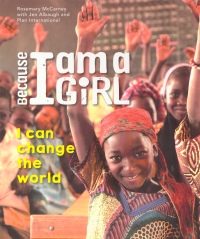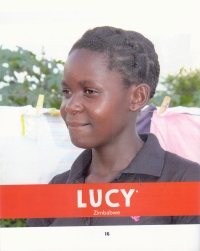| ________________
CM . . .
. Volume XXI Number 16. . . .December 19, 2014 
 |
Because I Am a Girl: I Can Change the World.
Rosemary McCarney with Jen Albaugh and Plan International.
Toronto, ON: Second Story Press, 2014.
95 pp., trade pbk. & epub, $16.95 (pbk.).
ISBN 978-1-927583-44-9 (pbk.), ISBN 978-1-927583-45-6 (epub).
Subject Headings:
Girls-Developing countries-Social conditions-Juvenile literature.
Girls-Developing countries-Biography-Juvenile literature.
Grades 4-7 / Ages 9-12.
Review by Gail Hamilton.
*** /4
|
| |
|

excerpt:
Every morning I would look out the window and watch some of the other girls pass by on their way to school. I wanted so badly to run outside and join in, to link arms with them and tell stories as we walked. But I had to stay and watch them disappear into the distance without me. All I had at home were three school notebooks, and I would pull them down off the kitchen shelf every night to study my old notes. After a while this was making me so heartsick that I made sure I was nowhere near the front window in the mornings. My notebooks started to gather dust on the shelf.
Inspired by her international development work, author Rosemary McCarney, head of Plan Canada, initiated the Because I Am a Girl movement. Her efforts also resulted in the United Nations declaring October 11th “International Day of the Girl” which advocates for girls’ rights on a global basis.
 The book begins with the “Because I Am a Girl” manifesto followed by the stories of eight girls from around the world, including Canada. Their stories are told in the first person, making them particularly poignant. For example, Anupa, from Nepal, was sold into domestic slavery for eight years, performing such tasks as cooking, cleaning, collecting cow dung for fertilizer, and caring for her master’s children. Barely able to hold her head up at the end of the day, she nevertheless had trouble sleeping, her bed a mat on the kitchen’s mud floor. She longed to be back at home with her family and to be able to attend school. Lucy, from Zimbabwe, was orphaned at a very young age, with only her older sister to care for her. Many times she went hungry, despite the fact that some of the people for whom she worked had promised her food as payment. The book begins with the “Because I Am a Girl” manifesto followed by the stories of eight girls from around the world, including Canada. Their stories are told in the first person, making them particularly poignant. For example, Anupa, from Nepal, was sold into domestic slavery for eight years, performing such tasks as cooking, cleaning, collecting cow dung for fertilizer, and caring for her master’s children. Barely able to hold her head up at the end of the day, she nevertheless had trouble sleeping, her bed a mat on the kitchen’s mud floor. She longed to be back at home with her family and to be able to attend school. Lucy, from Zimbabwe, was orphaned at a very young age, with only her older sister to care for her. Many times she went hungry, despite the fact that some of the people for whom she worked had promised her food as payment.
After each girl’s personal account, there is a “Did you know...” section which relates to the story. Topics include the myriad reasons why girls in many places do not attend school, the effects of hunger and the lack of clean water on health, forced marriages (sometimes a 12-year-old girl is promised in marriage to a man in his 40s), the dangers of early pregnancy, and stopping the cycle of poverty (it is estimated that 1.4 billion people live on $1.25 a day, and 70% of those people are female). The information is backed up with statistics. For instance, when girls are educated, their potential income increases by 15-25%, thereby increasing the country’s wealth as well.
Though the book is a real eye-opener, it also provides wonderful examples of projects and initiatives which are serving to help those in need. In Bangladesh, for example, a children’s organization is working with the government to establish “child marriage free zones”. When members of the organization hear of a pending arranged marriage, they talk with the girl’s parents to explain the negative impact that the early marriage can have on their daughter, and, if that does not work, they notify the authorities. Other groups counsel young girls on HIV awareness, train birth attendants, establish drop-in centres, or raise funds for bicycles so that girls do not have to walk 14 km each way to school every day. McCarney also gives several examples of conferences and organizations which are giving girls a voice.
The juxtaposition of personal accounts with facts and statistics is an effective tool, not only because readers can see that the stories, though written by individuals, are actually the stories of countless other girls, but also that much is being done to alleviate the problems, dangers and barriers that girls and young women face. As more people are made aware of the often horrific circumstances under which many females live, they might be spurred to social action. Vibrant, full-colour photographs depict the girls in their home environments and communities, further adding to the reader’s understanding.
At times heartbreaking, but, ultimately, hopeful, this book is well suited to middle school readers.
Recommended.
Gail Hamilton is a former teacher-librarian in Winnipeg, MB.

To comment
on this title or this review, send mail to cm@umanitoba.ca.
Copyright © the Manitoba Library Association. Reproduction for personal
use is permitted only if this copyright notice is maintained. Any
other reproduction is prohibited without permission.
Next Review
| Table of Contents For This Issue - December 19, 2014.
CM Home | Back Issues
| Search
| CM Archive
| Profiles Archive
|

 The book begins with the “Because I Am a Girl” manifesto followed by the stories of eight girls from around the world, including Canada. Their stories are told in the first person, making them particularly poignant. For example, Anupa, from Nepal, was sold into domestic slavery for eight years, performing such tasks as cooking, cleaning, collecting cow dung for fertilizer, and caring for her master’s children. Barely able to hold her head up at the end of the day, she nevertheless had trouble sleeping, her bed a mat on the kitchen’s mud floor. She longed to be back at home with her family and to be able to attend school. Lucy, from Zimbabwe, was orphaned at a very young age, with only her older sister to care for her. Many times she went hungry, despite the fact that some of the people for whom she worked had promised her food as payment.
The book begins with the “Because I Am a Girl” manifesto followed by the stories of eight girls from around the world, including Canada. Their stories are told in the first person, making them particularly poignant. For example, Anupa, from Nepal, was sold into domestic slavery for eight years, performing such tasks as cooking, cleaning, collecting cow dung for fertilizer, and caring for her master’s children. Barely able to hold her head up at the end of the day, she nevertheless had trouble sleeping, her bed a mat on the kitchen’s mud floor. She longed to be back at home with her family and to be able to attend school. Lucy, from Zimbabwe, was orphaned at a very young age, with only her older sister to care for her. Many times she went hungry, despite the fact that some of the people for whom she worked had promised her food as payment.